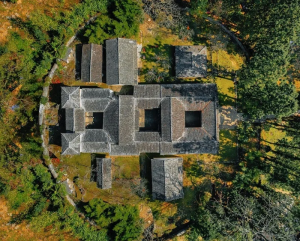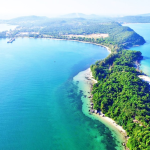Sapa and Ha Giang are two top destinations beloved by international tourists for their majestic natural beauty and diverse ethnic cultures. After completing their exploration in Sapa, visitors often proceed to Ha Giang. Consequently, many are interested in the travel details from Sapa to Ha Giang. Lily’s Travel Agency provides you with all the information on the journey from Sapa to Ha Giang.
An Overview of Ha Giang – The Mountainous Province at the Northernmost Point of Vietnam

Ha Giang, known as the northernmost point of Vietnam, is not only famous for its strategic location but also for its spectacular mountainous landscapes and rich culture. The province borders Cao Bang to the east, Yen Bai and Lao Cai to the west, Tuyen Quang to the south, and China to the north.
About the Terrain and Scenery
Ha Giang features diverse terrain, from deep valleys to steep mountains, creating a spectacular scenic picture. The winding and twisting roads present a real challenge for drivers. However, these difficulties offer visitors the opportunity to experience and admire the breathtaking natural beauty.
Ideal Time to Visit Ha Giang
Ha Giang boasts distinct beauty in each season. From August to October, visitors can enjoy the shimmering golden rice terraces during the main crop season, one of the famous highlights of the highlands. From October to November, the blooming buckwheat flowers create a romantic landscape, attracting thousands of tourists annually.
If you want to see the vibrant colors of yellow mustard flowers, white plum blossoms, and pink peach blossoms, plan a visit to Ha Giang around January. During the Lunar New Year, flowers bloom and cover the Northeastern mountains.
Traveling from Sapa to Ha Giang

For travelers from the north of Vietnam, getting to Ha Giang is quite convenient with many direct bus routes from major cities. If traveling from Sapa to Ha Giang, you can choose to go by motorcycle, personal car, or bus, depending on your needs and preferences.
Ha Giang is not only an ideal destination for those who love to explore nature, but it also preserves the unique cultural values of Vietnam’s ethnic minorities. This journey will undoubtedly be an unforgettable experience for anyone wanting to explore the majestic beauty of the nation.
Distance from Sapa to Ha Giang
Lao Cai and Ha Giang are two provinces located on the northern border of Vietnam, where Sapa is in the Northwest and Ha Giang in the Northeast. Both locations are not only geographically close but are also famous tourist destinations due to their breathtaking natural landscapes. The distance from Sapa to Ha Giang is not far, but the journey can be challenging due to the complex terrain.
Travel Distance
The distance from the town of Sapa to the center of Ha Giang city is about 240km. To reach the town of Dong Van in Ha Giang, you will need to travel a distance of 385km. This route includes many steep passes and winding roads through mountainous forests, making the journey both exciting and challenging.
The Beauty of Nature
The journey from Sapa to Ha Giang offers travelers the opportunity to behold the grand natural landscapes of Vietnam. From vast mountain forests and waterfalls hidden behind thin mists to lush valleys and towering mountains, each scene is a stunning painting.
Travel Considerations
Traveling on steep, winding roads, especially in bad weather conditions like rain or fog, can be very dangerous. Travelers need to be well-prepared regarding transportation and driving skills, and should regularly check the weather to ensure safety throughout the trip. Proper preparation not only ensures safety but also allows you to fully enjoy the beauty of the journey.
Cultural Experience
Along the way, travelers not only conquer the natural scenery but also have the opportunity to engage with the diverse culture of the ethnic minorities living there. Each village and small town along the route is not just a resting place but also a chance to connect and deeply experience the customs and lifestyles of the local people.
The journey from Sapa to Ha Giang, though arduous, is an indispensable experience for those who love exploration and wish to gain a deep understanding of the culture and nature of Vietnam.
Read more: Guide to 4 ways to travel from Hanoi to Ha Giang for tourists
How to Travel from Sapa to Ha Giang?
Traveling from Sapa to Ha Giang offers visitors various experiences depending on the mode of transportation. Below are two popular options you can consider to explore the beauty of the northern mountainous region of Vietnam.
Traveling by Motorcycle

For those who love adventure and want to fully enjoy the majestic beauty of the mountainous landscape, traveling by motorcycle is an ideal choice. This option is suited for visitors with strong driving skills, good health, and familiarity with traveling in hilly terrain. Although the journey may present many challenges, it will also offer opportunities to admire spectacular views and fully experience every moment on the road. Undoubtedly, these unforgettable memories will make the trip a lasting one.
Traveling by Bus
If you are not accustomed to traveling by motorcycle or are not thoroughly prepared for long journeys on challenging terrain, then the bus is a safe and convenient option. Buses from Sapa to Ha Giang are quite common and available throughout the day. You can catch the bus at the stations in Lao Cai, which is a suitable means for comfortably and safely exploring Ha Giang.
Tips for Bus Travel:
- Motion sickness: Since the journey from Sapa to Ha Giang is long and the roads are winding, you should prepare motion sickness medication if you frequently experience this condition.
- Bus schedule: Each bus operator has a different schedule, so you should call them directly to confirm the exact timetable and make reservations in advance.
- For foreign tourists, to ensure greater safety, we recommend choosing to travel by bus.
Regardless of the transportation method you choose, the journey from Sapa to Ha Giang always offers numerous opportunities to explore and experience the unique natural beauty and culture of the region. Choose the mode of transportation that best suits your health and personal preferences for a comfortable and safe trip!
Essential Sites You Cannot Miss When Exploring Ha Giang
When visiting Ha Giang, you must not miss the following attractive tourist spots:
Lung Cu Flag Tower

The Lung Cu Flag Tower is located at the peak of Dragon Mountain, within the territory of Long Son, Lung Cu, Dong Van, Ha Giang. It marks the northernmost point of Vietnam. Standing firm at an altitude of 1,470 meters above sea level, this site is not only one of the four extremities of the nation but also offers a unique cultural and historical experience for anyone wishing to explore the majestic beauty of this region.
Reconstructed in 2010, the tower features an octagonal shape, stands over 33 meters tall, and flies a 54 square meter flag representing the 54 ethnic groups of Vietnam. At its base are eight stone bas-reliefs depicting patterns from the Dong Son bronze drums and marking significant historical events of the nation.
The journey to the flag tower includes a climb of 839 steps, each revealing picturesque landscapes along the way. From the mountain summit, the expansive views of the Northeastern mountains and the cool air will leave visitors in awe and pride. Additionally, visitors can also stop by villages of the Lo Lo and Hmong people or enjoy the tranquil beauty of the Dragon’s Eye Waterhole, adding charm to the trip to Lung Cu Flag Tower.
Ma Pi Leng Pass
Ma Pi Leng Pass, one of the most treacherous roads in Ha Giang, spans approximately 20km and rises 1,200m above sea level, located on the Dong Van plateau. It not only presents a challenge to adventure enthusiasts but also serves as a significant cultural and economic lifeline for the local ethnic communities. This trail leading to the peak of the pass is part of the “Happiness Road”—an iconic route connecting the city of Ha Giang with Dong Van and the town of Meo Vac.
Standing atop Ma Pi Leng Pass, visitors can enjoy the fresh, cool air and behold the breathtaking views of the layered mountains and the serene, graceful flow of the Nho Que River winding below. The perfect combination of natural beauty and historical and cultural value makes Ma Pi Leng Pass a magical and indispensable symbol of Ha Giang.
Dong Van Karst Plateau
The Dong Van Karst Plateau, located in Hà Giang province, is one of the most attractive destinations in northern Vietnam. Situated over 1,000 meters above sea level, it includes the districts of Yen Minh, Dong Van, Quan Ba, and Meo Vac, and is distinguished by its majestic limestone mountains and a diverse cultural landscape. Notably, the Dong Van Karst Plateau is not only a region filled with historical traces of the Earth’s geological development but also a site of significant geological heritage. Visitors to the plateau have the opportunity to explore the pristine beauty of nature and experience the unique traditional culture of the highland ethnic groups. It is an ideal destination for those seeking a deep understanding of Vietnam’s history, culture, and natural beauty.
Nho Que River

The Nho Que River, an essential stop in the exploration of Ha Giang, originates from the Nghiem Son mountains in Yunnan, China, and flows northwest to southeast into Vietnam. The river’s upper reaches, flowing from Seo Lung village in Lung Cu through the Hem Tu San, are exceptionally beautiful and captivating. From high above, the winding river carves through the pristine wilderness, creating a majestic and enchanting natural scene. Here, visitors not only admire the poetic beauty of the river but also experience an unusual sense of tranquility and romance.
Dong Van Old Quarter
Located within the town of Dong Van in Hà Giang province, the Đồng Văn Old Quarter is a unique architectural and cultural landmark from the 20th century. The area is not only home to many ethnic minorities but also symbolizes the preservation of the unique culture of the karst plateau. Tourists visiting the Old Quarter can see about 40 century-old houses standing side by side, surrounded by majestic mountains. The morning sunlight casts a golden hue over the gray walls, creating an unforgettable atmosphere of peace and antiquity.
Especially during the festival days from the 14th to the 16th of the third lunar month each year, Đong Van Old Quarter dresses up in a festive garb with bright red lanterns and a wealth of cultural activities. A visit to the Đồng Văn market in the center of the Old Quarter is a wonderful way to experience the rich and diverse culture of the local people. Embark on a journey to explore Đồng Văn Old Quarter, where every stone and every wall tells a story of local history and culture.
Hoang Su Phi Terraced Fields
When mentioning Ha Giang, one of the must-visit tourist spots is the Hoang Su Phi terraced fields, which are recognized as a national scenic spot. Covering a total area of 3,700 hectares, this region includes 24 communes and towns, becoming a cultural icon and a unique landscape of rural northern Vietnam.
The terraced fields in Hoang Su Phi are not merely cultivation areas but also artworks of nature and human endeavor, with naturally meandering plots along hill slopes, creating a picturesque and romantic scene. Thousands of tourists visit each year not only to admire the majestic beauty of the fields but also to explore the life and distinctive culture of the local community. A visit to Hoàng Su Phì also offers the chance to enjoy crystal-clear streams and explore pristine forests, providing truly unforgettable experiences.
The Vuong Family Mansion

The Vuong Family Mansion, located on top of a small hill in Ha Giang, is not only a symbol of unique architecture but also an important historical site, recognized as a national monument since 1993. The mansion’s architecture is a refined combination of French style, the Mong ethnic culture, and distinctive Chinese influences, creating a space that is both ancient and modern.
Visitors can not only admire the impressive architectural beauty but also enjoy a panoramic view of the magnificent and majestic surrounding valley from above. The Vuong Family Mansion is not just a tourist attraction but also a place to delve deeper into the culture and history of Ha Giang.
Real more: 10 Best things to do in Ha Giang
Lo Lo Chai Village
Lo Lo Chai Village, located at the foot of Dragon Mountain in Lung Cu commune, Dong Van district, Ha Giang province, is an unmissable destination for those who love exploring the unique culture and landscape of Vietnam. It is home to two indigenous ethnic groups: the MOng and the Lo Lo, who have lived here for generations. Lo Lo Chai Village is increasingly asserting itself as a prominent cultural community tourism spot on the Dong Van plateau. Here, visitors can immerse themselves in the deep green of the majestic mountains, view the sharp rocky slopes, and learn about the unique traditional culture of the Lo Lo people, gradually unfolding unforgettable experiences.
For a safe, enjoyable, and memorable exploration of northern Vietnam’s mountains, international travelers should not forget to check out the tours offered by LiLy’s Travel Agency. We provide all-inclusive tours, ensuring a wonderful trip for you.
Find out more about Ha Giang tours here: Northern Vietnam Tour















